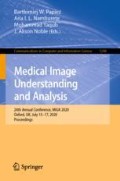Abstract
The combination of datasets is vital for providing increased statistical power, and is especially important for neurological conditions where limited data is available. However, our ability to combine datasets is limited by the addition of variance caused by factors such as differences in acquisition protocol and hardware. We aim to create scanner-invariant features using an iterative training scheme based on domain adaptation techniques, whilst simultaneously completing the desired segmentation task. We demonstrate the technique using an encoder-decoder architecture similar to the U-Net but expect that the proposed training scheme would be applicable to any feedforward network and task. We show that the network can be used to harmonise two datasets and also show that the network is applicable in the common scenario of limited available training data, meaning that the network should be applicable for real-world segmentation problems.
Access this chapter
Tax calculation will be finalised at checkout
Purchases are for personal use only
References
Alfaro-Almagro, F., et al.: Image processing and quality control for the first 10,000 brain imaging datasets from UK biobank. bioRxiv 166, 130385, April 2017
Alvi, M., Zisserman, A., Nellåker, C.: Turning a blind eye: explicit removal of biases and variation from deep neural network embeddings. In: Leal-Taixé, L., Roth, S. (eds.) ECCV 2018. LNCS, vol. 11129, pp. 556–572. Springer, Cham (2019). https://doi.org/10.1007/978-3-030-11009-3_34
Dewey, B., et al.: DeepHarmony: a deep learning approach to contrast harmonization across scanner changes. Magn. Reson. Imaging 64, 160–170 (2019)
Fortin, J.P., et al.: Harmonization of cortical thickness measurements across scanners and sites. NeuroImage 167 (2017). https://doi.org/10.1016/j.neuroimage.2017.11.024
Ganin, Y., Lempitsky, V.S.: Unsupervised domain adaptation by backpropagation. ArXiv (2014)
Ganin, Y., et al.: Domain-adversarial training of neural networks. J. Mach. Learn. Res. 17, 59:1–59:35 (2015)
Hoffman, J., Tzeng, E., Darrell, T., Saenko, K.: Simultaneous deep transfer across domains and tasks. In: 2015 IEEE International Conference on Computer Vision (ICCV), pp. 4068–4076 (2015)
Kamnitsas, K., et al.: Unsupervised domain adaptation in brain lesion segmentation with adversarial networks (12 2016)
Marcus, D., Wang, T., Parker, J., Csernansky, J., Morris, J., Buckner, R.: Open access series of imaging studies (OASIS): cross-sectional MRI data in young, middle aged, nondemented, and demented older adults. J. Cogn. Neurosci. 19, 1498–507 (2007). https://doi.org/10.1162/jocn.2007.19.9.1498
Pomponio, R., et al.: Harmonization of large MRI datasets for the analysis of brain imaging patterns throughout the lifespan. NeuroImage 208, 116450 (2019). https://doi.org/10.1016/j.neuroimage.2019.116450
Ronneberger, O., Fischer, P., Brox, T.: U-net: convolutional networks for biomedical image segmentation. In: Navab, N., Hornegger, J., Wells, W.M., Frangi, A.F. (eds.) MICCAI 2015. LNCS, vol. 9351, pp. 234–241. Springer, Cham (2015). https://doi.org/10.1007/978-3-319-24574-4_28
Sudlow, C., et al.: UK Biobank: an open access resource for identifying the causes of a wide range of complex diseases of middle and old age 12, e1001779, March 2015
Wachinger, C., Rieckmann, A., Pölsterl, S.: Detect and correct bias in multi-site neuroimaging datasets. bioRxiv, February 2020
Wilson, G., Cook, D.J.: A survey of unsupervised deep domain adaptation (2018)
Zhang, Y., Brady, M., Smith, S.: Segmentation of brain MR images through a hidden Markov random field model and the expectation maximization algorithm. IEEE Trans. Med. Imaging 20, 45–57 (2001). https://doi.org/10.1109/42.906424
Zhao, F., et al.: Harmonization of infant cortical thickness using surface-to-surface cycle-consistent adversarial networks. In: Shen, D., et al. (eds.) MICCAI 2019. LNCS, vol. 11767, pp. 475–483. Springer, Cham (2019). https://doi.org/10.1007/978-3-030-32251-9_52
Zhu, J.Y., Park, T., Isola, P., Efros, A.A.: Unpaired image-to-image translation using cycle-consistent adversarial networks. In: 2017 IEEE International Conference on Computer Vision (ICCV), pp. 2242–2251 (2017)
Acknowledgements
ND is supported by the Engineering and Physical Sciences Research Council (EPSRC) and Medical Research Council (MRC) [grant number EP/L016052/1]. MJ is supported by the National Institute for Health Research (NIHR) Oxford Biomedical Research Centre (BRC), and this research was funded by the Wellcome Trust [215573/Z/19/Z]. The Wellcome Centre for Integrative Neuroimaging is supported by core funding from the Wellcome Trust [203139/Z/16/Z]. AN is grateful for support from the UK Royal Academy of Engineering under the Engineering for Development Research Fellowships scheme.
The computational aspects of this research were supported by the Wellcome Trust Core Award [Grant Number 203141/Z/16/Z] and the NIHR Oxford BRC. The views expressed are those of the author(s) and not necessarily those of the NHS, the NIHR or the Department of Health.
Author information
Authors and Affiliations
Corresponding author
Editor information
Editors and Affiliations
Rights and permissions
Copyright information
© 2020 Springer Nature Switzerland AG
About this paper
Cite this paper
Dinsdale, N.K., Jenkinson, M., Namburete, A.I.L. (2020). Unlearning Scanner Bias for MRI Harmonisation in Medical Image Segmentation. In: Papież, B., Namburete, A., Yaqub, M., Noble, J. (eds) Medical Image Understanding and Analysis. MIUA 2020. Communications in Computer and Information Science, vol 1248. Springer, Cham. https://doi.org/10.1007/978-3-030-52791-4_2
Download citation
DOI: https://doi.org/10.1007/978-3-030-52791-4_2
Published:
Publisher Name: Springer, Cham
Print ISBN: 978-3-030-52790-7
Online ISBN: 978-3-030-52791-4
eBook Packages: Computer ScienceComputer Science (R0)

